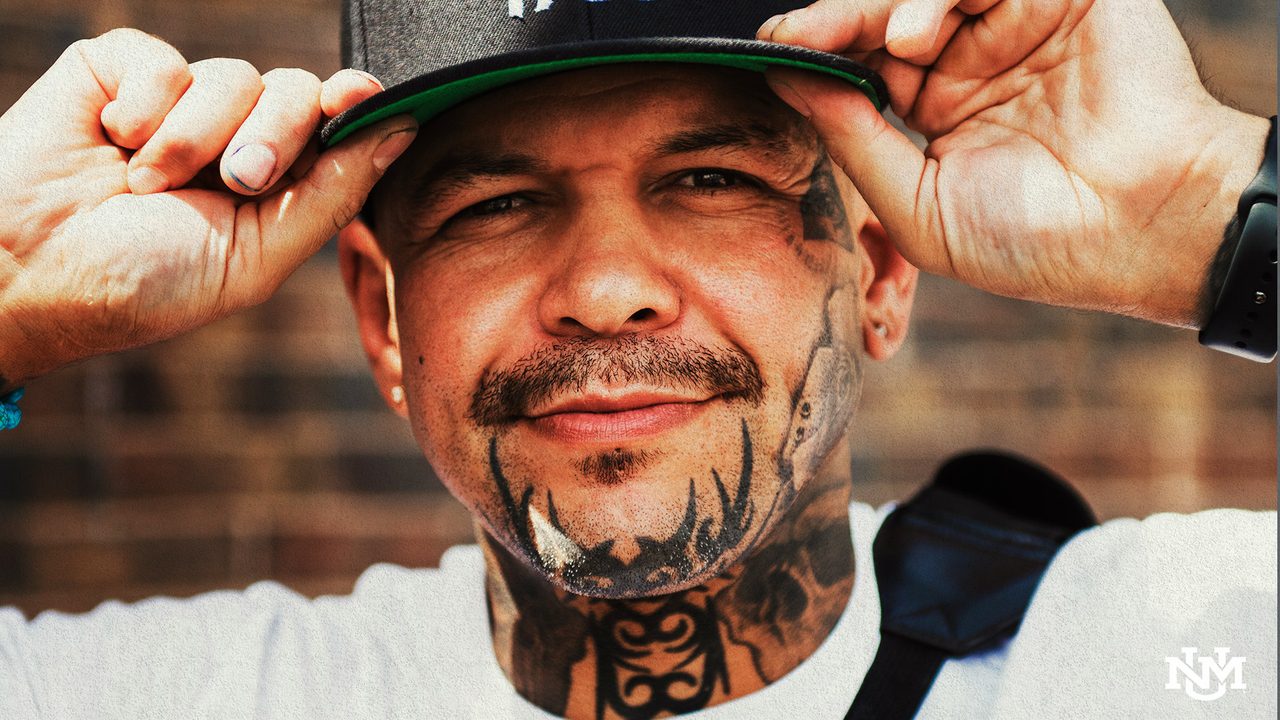
Born into a cycle of addiction, University of New Mexico senior Gerald Lovato was a child when he first realized the power of creating art to escape and heal from trauma. Lovato majored in Fine Arts with a studio concentration in Painting and Photography, and minoring in Arts Business + Leadership. He officially graduates this month but walked in the spring ceremony held by El Centro de la Raza.
“It is only offered once per year, and it was important to represent my cultural heritage when graduating. I was awarded the 2022 Raza Excellence Award,” Lovato explained.
An Albuquerque native, Lovato has traveled a rough and harrowing road to become a UNM art student. Last year, he lost his nephew to a drive-by shooting and the year before his brother was murdered. In 2002, Lovato was a victim of a knife attack in Albuquerque.
“I was stabbed in the face, arm, and leg and nearly bled out. The ulnar nerve in my arm was severed, paralyzing my dominant right hand. My physical therapist recommended I try martial arts to cope with the trauma and build mobility in my hand, which led to a nearly 10-year career in professional mixed martial arts (MMA) competition. When I retired from MMA competition, I began to explore the idea of becoming an artist. Gaining the use of my hand again inspired me to attempt to be an artist… I believe being an older non-traditional student with a large amount of life experience has contributed to my success. I also feel that I bring a lot to the classroom with my perspective.”
Lovato is using his art for not only sharing his own story but also giving the community an opportunity to be heard. He presented his non-traditional Honors exhibition in October to an audience not just from UNM, but also the community.
The exhibition focused on themes that greatly exemplify major problems facing New Mexicans in all demographics.
“After losing so many loved ones in a short period of time while making this body of work, I began to research New Mexico data on suicide, gun violence, and drug addiction, or more specifically the fentanyl epidemic, to find parallels. My research found we rank higher than the national average in New Mexico on all these themes post-pandemic. My research found all these themes to be rooted in behavioral health. My research within the context of art history explored how my work can be social praxis in my community. I then found connections in my attempts to inspire a social movement within my community through the theory of artivism, which is a continuation of what first began in the Chicana Feminist Movement in the 1960-1970s… This research helped me make decisions while I was making my work and ultimately influenced my overall goal for my thesis exhibition which is community impact through artistic intervention.”
Lovato said his undergraduate experience helped him to explore and identify my place within the contemporary art world.
“Knowing who I am as an artist is the impetus behind my current body of work.”
But finding his way in the world of art wasn’t easy.
“I was asked by a professor, where does my art fit in art history? Well, according to art history, I don’t exist. Academia is pressuring me to find an artist in art history to be influenced by, however, the only place I find in art history that I relate to is in my Chicana/o/x studies courses. Dr. Kency Cornejo, my Latinx art history professor helped to expose me to artists who were doing similar work as me in contemporary art.”
Lovato credited several other professors for helping him through his time at UNM.
“I have had some of the most wonderful professors at UNM,” Lovato said. “The most powerful connection I had was with my photography professor, Shelby Roberts. She has believed in me since the beginning. My thesis committee was made up of a group of bad-asses, Raychael Stine, Meggan Gould, and Stephanie Woods. They have all had strong impacts on me.”
Now applying to graduate school for a Master of Fine Arts program, Lovato hopes to continue his education in Fall 2023. As a social practice artist by way of artivism, he eventually plans to launch a nonprofit youth mentorship program for disadvantaged youth in Albuquerque.
“I am applying to some competitive schools including Columbia, UCLA, and Yale so wish me luck! Graduate school will help me develop my art practice in my research around behavioral health which will give me the tools to return to New Mexico and serve my community through the arts.”
